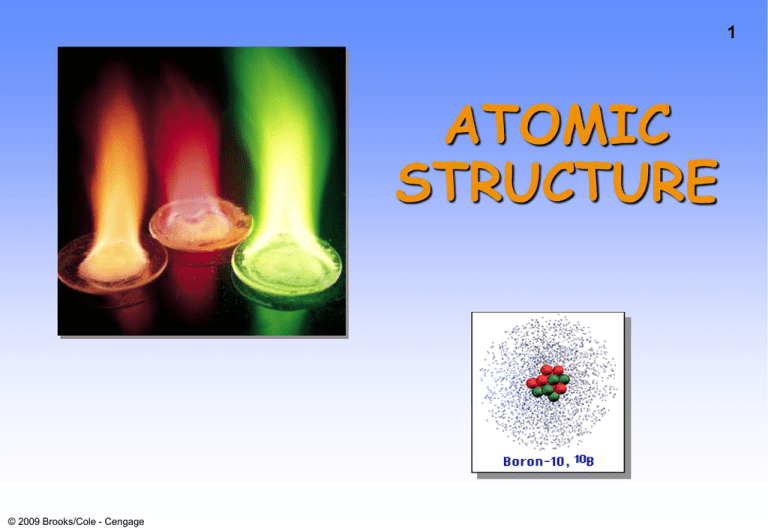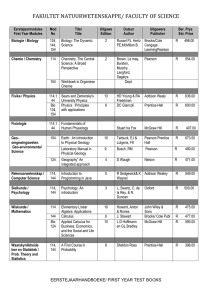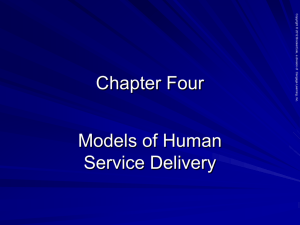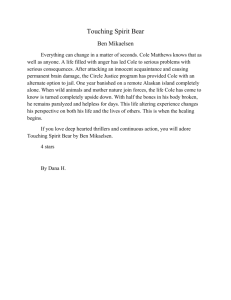Lecture 6 - Chemistry at Winthrop University
advertisement

1 ATOMIC STRUCTURE © 2009 Brooks/Cole - Cengage Atomic Structure • Much of what we know about the very nature of matter and the universe around us is due to the work of pioneering chemists, mathematicians and physicists in the late 19th and early 20th centuries » No Computers, calculators, Starbucks, cell phones or even ELECTRICITY • This knowledge sprang from studies on light » What is it? » How do atoms interact with it? » How is it made? © 2009 Brooks/Cole - Cengage 2 Electromagnetic Radiation 3 • In 1864 James Maxwell developed a mathematical way to describe radiation (what was going on in America at the time?), • He said that radiation is a wave with electric and magnetic fields at right angles to each other move together • Since it is a wave, it has the following characteristics of all waves – Wavelength: λ (lambda) = The distance between successive crests of a wave. It is measured in units of distance (nanometers, micrometers, meters) – Frequency: ν (nu) = The number of waves that pass a given point in some amount of time (usually per second). It is measured in Hertz (Hz) or s-1 • The speed of an electromagnetic wave is defined as: c = λν where c is the Universal Constant = 3.00 x108 m/s © 2009 Brooks/Cole - Cengage 4 Electromagnetic Radiation wavelength Visible light Amplitude wavelength Ultraviolet radiation © 2009 Brooks/Cole - Cengage Node 5 Electromagnetic Radiation © 2009 Brooks/Cole - Cengage Electromagnetic Radiation Long wavelength , small frequency v Short wavelength , high frequency v increasing frequency © 2009 Brooks/Cole - Cengage increasing wavelength 6 Electromagnetic Radiation Red light has = 700 nm. Calculate the frequency. 1 x 10-9 m = 7.00 x 10-7 m 700 nm 1 nm 8 Freq = 3.00 x 10 m/s -7 7.00 x 10 © 2009 Brooks/Cole - Cengage m 4.29 x 1014 sec-1 7 Electromagnetic Radiation Short wavelength high frequency high energy Long wavelength small frequency low energy © 2009 Brooks/Cole - Cengage 8 9 Electromagnetic Spectrum © 2009 Brooks/Cole - Cengage Let’s look at an object being heated 10 • The emitted light from a heated object comes from a collection of oscillators – Some at high energy, some at intermediate energy, some at low energy • In 1879, Josef Stefan determined that the total intensity of all radiation emitted from a heated object increases as the fourth power of temperature – Intensity=(5.67x10-8Wm-2K-4) · T4 » 1 Watt (W) = 1J/sec © 2009 Brooks/Cole - Cengage Wien’s Law 11 Wilhelm Wien studied the relationship between temperature and the wavelength of maximum intensity in a black body emitter. He found that as Temperature INCREASES, the wavelength of maximum emission DECREASES We can summarize this in Wien’s Law: Tmax = Constant = 2.9 K•mm © 2009 Brooks/Cole - Cengage Quantization of Energy (Planck and Einstein) 12 • For centuries people have observed that as you heat an object, it goes from red to orange-yellow to white – The phrase “white hot” comes from this • What are we actually observing? • This emitted light is an indicator of the heat given off by the object • The problem scientists in the 1800’s had was that it was theorized that the more heat you put into an object, the higher the intensity of radiation that would be emitted at decreasing wavelength “The Ultraviolet Catastrophe” © 2009 Brooks/Cole - Cengage 13 The Ultraviolet Catastrophe • According to Classical Physics at the time, having a cookout should turn into a nightmare. • The grill should be emitting x-ray and gamma ray radiation • But we know this doesn’t happen. • Max Planck studied this and found… © 2009 Brooks/Cole - Cengage Quantization of Energy •Planck deduced that energy would be quantized and this explained the “Catastrophe” •With quantization, only radiation of certain energies would be emitted See Chem & Chem Reactivity, Figure 6.3 © 2009 Brooks/Cole - Cengage 14 15 Quantization of Energy An object can gain or lose energy by absorbing or emitting radiant energy in QUANTA. Energy of radiation is proportional to frequency E = h· h = Planck’s constant = 6.6262 x 10-34 J·s © 2009 Brooks/Cole - Cengage 16 Quantization of Energy E = h· Light with large (small ) has a small E. Light with a short (large ) has a large E. © 2009 Brooks/Cole - Cengage Let’s look at an object being heated • As we heat a metal bar, the atoms in the bar vibrate faster • The atoms are called oscillators • As they drop back down to a lower vibrational state they emit some radiation • Each oscillator has a fundamental frequency and the energy of the emitted radiation is a multiple of this frequency (this is where n comes into play) • For a single energy level change, the equation becomes: E=hν © 2009 Brooks/Cole - Cengage (Planck’s Equation) 17 Energy of Radiation Energy of 1.00 mol of photons of red light. E = h· = (6.63 x 10-34 J·s)(4.29 x 1014 s-1) = 2.85 x 10-19 J per photon E per mol = (2.85 x 10-19 J/ph)(6.02 x 1023 ph/mol) = 172 kJ/mol © 2009 Brooks/Cole - Cengage 18 Photoelectric Effect Experiment demonstrates the particle nature of light. © 2009 Brooks/Cole - Cengage 19 Photoelectric Effect Classical theory said that E of ejected electron should increase with increase in light intensity—not observed! • No e- observed until light of a certain minimum E (or frequency, remember Placnk’s equation?) is used. – Once this value is reached, electrons are immediately ejected • Number of e- ejected depends on light intensity. • The kinetic energy of the ejected electrons increases with the frequency of the incident radiation © 2009 Brooks/Cole - Cengage A. Einstein (18791955) 20 Photoelectric Effect Understand experimental observations if light consists of particles called PHOTONS of discrete energy. © 2009 Brooks/Cole - Cengage 21 Photoelectric Effect 22 • Einstein explained the observations of photo-electric experiments by combining Planck’s equation with a new concept – Light has particle-like properties – Massless packets of energy are called PHOTONS (hv) and the energy of the packets is proportional to their frequency • No electrons are ejected by the metal if the incident photons do not have a high enough energy • If the frequency is high enough, the energy is high enough and an electron is knocked off © 2009 Brooks/Cole - Cengage A. Einstein (18791955) 23 Photoelectric Effect Let’s look at this in more detail: If we have a stream of photons colliding with a metal object, some of those photons are going to collide with the electrons in the metal The photons have an energy associated with them (hv) but this value must be above a certain minimum to eject an electron from the metal. Different metals do not release electrons with the exact same incident photons The metals want to hold onto the electrons and have a characteristic energy value associated with them called a WORK FUNCTION, If the energy of the incident photons is greater than , then the metal releases electrons 1/2me Ek of ejected electron © 2009 Brooks/Cole - Cengage v2 = hv - Work function of metal Energy of incident photon Atomic Line Emission Spectra and Niels Bohr • It has long been known that applying high voltage to a tube containing a gas would result in the gas giving off light • However, if we split the light into its component wavelengths with a prism, we’ll see a small number of lines at specific colors (wavelengths) © 2009 Brooks/Cole - Cengage 24 Line Emission Spectra of Excited Atoms • Excited atoms emit light of only certain wavelengths • The wavelengths of emitted light depend on the element. QuickTime™ and a Graphics decompressor are needed to see this picture. © 2009 Brooks/Cole - Cengage 25 Line Emission Spectra of Excited Atoms High E Short High Low E Long Low Visible lines in H atom spectrum are called the BALMER series. © 2009 Brooks/Cole - Cengage 26 27 Line Spectra of Other Elements Why do elements emit at certain characteristic wavelengths? Balmer and Rydberg developed an explanation for the line emission behaviour (Rydberg Formula) 1 1 R 2 2 n1 n 2 © 2009 Brooks/Cole - Cengage R = Rydberg Constant = 1.0974x10-3 m-1 Line Spectra 1 1 R 2 2 n1 n 2 R = Rydberg Constant = 1.0974x10-3 m-1 When n1=2 (and n2=2, 3, 4…) You can calculate the Balmer Series of lines When n1=1 (and n2=2, 3, 4…) You can calculate the Lyman Series of lines © 2009 Brooks/Cole - Cengage 28 29 What do Line Spectra Tell Us? The characteristic line spectra of each element tells us that electrons can only have certain SPECIFIC energies (that’s what those n values mean, but more on that in a minute) Each element has a unique configuration of electrons as evidenced by their unique line spectra © 2009 Brooks/Cole - Cengage Atomic Spectra and Bohr One view of atomic structure in early 20th century was that an electron (e-) traveled about the nucleus in an orbit. 1. Any orbit should be possible and so is any energy. 2. But a charged particle moving in an electric field should emit energy. End result should be destruction! © 2009 Brooks/Cole - Cengage 30 Atomic Spectra and Bohr Bohr said classical view is wrong. Need a new theory — now called QUANTUM or WAVE MECHANICS. e- can only exist in certain discrete orbits — called stationary states. e- is restricted to QUANTIZED energy states. Energy of state = - Rhc/n2 where n = quantum no. = 1, 2, 3, 4, .... © 2009 Brooks/Cole - Cengage 31 Atomic Spectra and Bohr Energy of quantized state = - Rhc/n2 • Only orbits where n = some positive integer are permitted. • The energy of an electron in an orbit has a negative value • An atom with its electrons in the lowest possible energy level is at GROUND STATE © 2009 Brooks/Cole - Cengage 32 Atomic Spectra and Bohr If e-’s are in quantized energy states, then ∆E of states can have only certain values. This explain sharp line spectra. PLAY MOVIE © 2009 Brooks/Cole - Cengage 33 34 Energy Adsorption/Emission © 2009 Brooks/Cole - Cengage Origin of Line Spectra Balmer series © 2009 Brooks/Cole - Cengage 35 36 Atomic Line Spectra and Niels Bohr Niels Bohr (1885-1962) © 2009 Brooks/Cole - Cengage Bohr’s theory was a great accomplishment. Rec’d Nobel Prize, 1922 Problems with theory — • theory only successful for H. • introduced quantum idea artificially. • So, we go on to QUANTUM or WAVE MECHANICS Wave-Particle Duality L. de Broglie (1892-1987) © 2009 Brooks/Cole - Cengage de Broglie (1924) proposed that all moving objects have wave properties. For light: E = mc2 E = h = hc / Therefore, mc = h / and for particles (mass)(velocity) = h / 37 Wave-Particle Duality QuickTime™ and a Graphics decompressor are needed to see this picture. Experimental proof of wave properties of electrons Baseball (115 g) at 100 mph = 1.3 x 10-32 cm e- with velocity = 1.9 x 108 cm/sec = 0.388 nm •The mass times the velocity of the ball is very large, so the wavelength is very small for the baseball •The deBroglie equation is only useful for particles of very small mass © 2009 Brooks/Cole - Cengage 38







